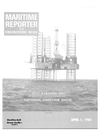
Page 54: of Maritime Reporter Magazine (April 1984)
Read this page in Pdf, Flash or Html5 edition of April 1984 Maritime Reporter Magazine
ASNE Day (continued from page 57) the methodology starts with devel- oping a seakeeping-optimized hull form without making concessions to other performance considera- tions, such as resistance. The sea- keeping-optimized hull is then modified to achieve improvement in other performance characteris- tics without degrading the sea- keeping. Presented is a point-de- sign example produced by this methodology.
Merits of the methodology and the point-design are assessed on the basis of theoretical calcula- tions and model experiments. This methodology utilizes a subset of the Hull Form Design System that is used at NAVSEA. A brief de- scription of the function and capa- bilities of the programs in this subset, and their relation to the total HFDS are discussed.
Diplomat Room—Session 4B
Ship Propulsion
Moderator:
Dr. Warren C. Dietz
James L. Corder, assistant 2:30 p.m. "Testing of a Magnetically
Treated West German Diesel En- gine," by LCdr. James W. White,
USN.
The biggest name in Canadian Shipbuilding.
A leading name in offshore rigs and major industrial projects.
Davie has been building massive steel structures for a long, long time. Notably ships. Destroyers, tankers, icebreakers, supply vessels.
Davie's innovative approach, its vast expertise, plus its large industrial capacity is supported by an energetic and skilled workforce. No wonder that Davie was able to respond so capably to the offshore industry's need for rigs in the late 70's and early 80's and is now ready in this era of super rigs. There are many good reasons to involve DAVIE in your ship construction and offshore development project.
Speak to us about it.
DAVIE DAVIE
MMMM SHIPBUILDING
LIMITED
P.O. Box 130. LEVIS
QUEBEC G6V6N7
TELEPHONE (418)837-5841
TELEX 051-2254
Aluminum-block, non-magnetic diesel engines have been less reli- able in service than their cast-iron counterparts. Additionally, non- ferrous engines are produced in small numbers exclusively for mil- itary use and thus have no com- mercial base with which to en- hance logistics support.
A West German manufacturer,
Motoren-und Turbinen-Union
Friedrichshafen GmbH (MTU), has developed a method for magneti- cally treating cast-iron engines in such a way as to reduce their mag- netic signatures and thus make them available for mine counter- measures applications.
In order to take advantage of the improved reliability and sup- portability of ferrous but magneti- cally treated production engines, the U.S. Navy conducted an exten- sive test and evaluation program to confirm or deny the suitability of the engine for a new class of mine countermeasures ships.
This paper describes the unique characteristics of the MTU 6V396TB63 diesel engine, and will consolidate and illustrate the re- sults of endurance, shock, mag- netic, and maintenance testing. 3:15 p.m. "Surface-Hardened Naval Ma- rine Gears with Reference to Al- ternative Means of Surface Hard- ening," by Roger Barker and
George C. Mudd.
It has become common practice in naval marine gear units of Eu- ropean manufacture to take ad- vantage of the greater load-carry- ing capacity resulting from a surface-hardening process. The surface-hardening processes avail- able to the gear designer are many and varied, each having advan- tages and disadvantages.
This paper examines the three principal applicable processes, ex- plains the characteristics of each and how the disadvantages may be controlled. The load-carrying capacity of gears made with the different surface treatments is then discussed, including the effects of hardness gradient, residual stress, and size on capacity. 4:00 p.m. "Advanced-Cycle Gas Turbines for Naval Ship Propulsion," by
Thomas L. Bowen and Dan A.
Groghan.
Investigations are currently being conducted by the Navy and several contractors to determine the technical feasibility and cost effectiveness of advanced regener- ative or intercooled-regenerative gas turbines as naval propulsion engines for future mid-size surface combatants. A comparison of the performance characteristics of these engines indicates that significant increases in the thermal efficiency above current simple-cycle en- gines may result by adding heat exchangers for regeneration alone (continued on page 62) 52 Circle 159 on Reader Service Card Maritime Reporter/Engineering News

 53
53

 55
55
